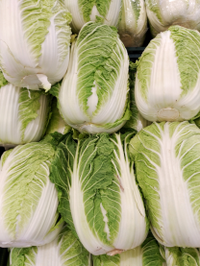
Photo from wikipedia
Chinese cabbage tipburn is characterized by the formation of necrotic lesions on the margin of leaves, including on the insides of the leafy head. This physiological disorder is associated with… Click to show full abstract
Chinese cabbage tipburn is characterized by the formation of necrotic lesions on the margin of leaves, including on the insides of the leafy head. This physiological disorder is associated with a localized calcium deficiency during leaf development. However, little information is available regarding the molecular mechanisms governing Ca-deficiency-triggered tipburn. This study comprehensively analysed the transcriptomic comparison between control and calcium treatments (CK and 0 mM Ca) in Chinese cabbage to determine its molecular mechanism in tipburn. Our analysis identified that the most enriched gene ontology (GO) categories are photosynthesis, thylakoid and cofactor binding. Moreover, the KEGG pathway was most enriched in photosynthesis, carbon metabolism and carbon fixation. We also analyzed the co-expression network by functional categories and identified ten critical hub differentially expressed genes (DEGs) in each gene regulatory network (GRN). These DEGs might involve abiotic stresses, developmental processes, cell wall metabolism, calcium distribution, transcription factors, plant hormone biosynthesis and signal transduction pathways. Under calcium deficiency, CNX1, calmodulin-binding proteins and CMLs family proteins were downregulated compared to CK. In addition, plant hormones such as GA, JA, BR, Auxin and ABA biosynthesis pathways genes were downregulated under calcium treatment. Likewise, HATs, ARLs and TCP transcription factors were reported as inactive under calcium deficiency, and potentially involved in the developmental process. This work explores the specific DEGs’ significantly different expression levels in 0 mM Ca and the control involved in plant hormones, cell wall developments, a light response such as chlorophylls and photosynthesis, transport metabolism and defence mechanism and redox. Our results provide critical evidence of the potential roles of the calcium signal transduction pathway and candidate genes governing Ca-deficiency-triggered tipburn in Chinese cabbage.
Journal Title: Plants
Year Published: 2022
Link to full text (if available)
Share on Social Media: Sign Up to like & get
recommendations!